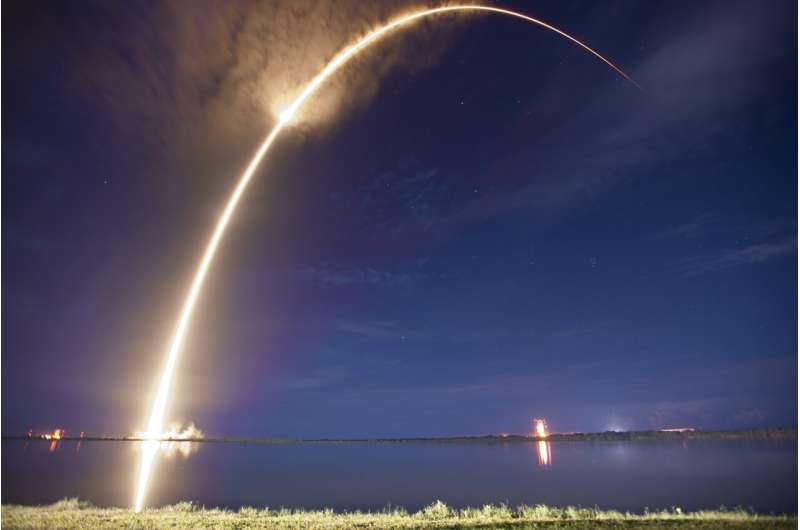
The Space Force is giving a nearly even share of 21 upcoming national security launches between SpaceX and United Launch Alliance.
Space Systems Command, which manages a $15 billion budget for the Department of Defense to ensure U.S. strategic advantage in space, announced ULA will provide 11 missions on its new Vulcan Centaur rocket while SpaceX will be responsible for 10 missions on its Falcon 9 or Falcon Heavy rockets as part of the National Security Space Launch (NSSL) Phase 2 Launch Service Procurement contract for fiscal year 2024, which began on Oct. 1.
This is the fifth and final year of the NSSL Phase 2 contract, and will be for missions flown over the next two to three years. The majority of launches will come from ULA and SpaceX’s launch facilities at Cape Canaveral Space Force Station, although Falcon Heavy launches if required are limited to Kennedy Space Center, and both ULA and SpaceX can launch from Vandenburg Space Force Base in California.
“Over the five-year Phase 2 contract, we will have ordered a total of 48 missions, a significant increase over the 34 missions originally estimated leading up to Phase 2,” said Brig. Gen. Kristin Panzenhagen in a press release. She heads the Space Force’s Assured Access to Space program within Space Systems Command.
Panzenhagen is also the head of Space Launch Delta 45 based at Patrick Space Force Base and overseas the Eastern Range having taken over from Maj. Gen. Stephen Purdy earlier this year. She and Purdy combined to supervise a record-breaking 59 launches from Canaveral and KSC so far, a number that could surpass 70 before the end of the year.
“The increase in launch tempo is a clear reminder of how vital space-based capabilities are in providing our warfighters and our nation’s decision-makers with the information needed to stay ahead of and to deter adversarial forces,” she said in the release.
ULA’s much-delayed Vulcan Centaur has yet to make its first flight, but is slated to launch as early as Dec. 24 on a mission to send a commercial lunar lander to the moon for NASA. It’s ULA’s replacement for its Atlas V and Delta IV family of rockets.
The final Delta IV Heavy launch is set for next year on a Space Force mission, while 17 Atlas V rockets remain for a mix of missions including Boeing’s crewed Starliner flights, Amazon’s Project Kuiper satellites and one final Space Force launch targeting the spring. Several future Space Force missions already awarded to ULA in earlier rounds of the Phase 2 contract continue to wait on Vulcan Centaur, as none can fly until ULA completes two certification flights, which it aims to do by April.
This latest Space Force award assigned to ULA missions dubbed GPS III-9, NROL-73, NROL-56, STP-5, SILENTBARKER 2/NROL-118, GPS IIIF-1, NROL-100, USSF-95, NROL-109, SDA T2TL-B and USSF-25.
SpaceX’s missions are named SDA T1TL-F, SDA T1TR-A, USSF-57, NROL-77, SDA T1TR-E, GPS III-10, USSF-75, SDA T2TL-A, SDA T2TL-C and USSF-70.
NROL missions are in partnership with the National Reconnaissance Office. The SDA missions are for the Space Development Agency. The GPS missions add to the DOD’s global positioning satellite holdings. STP missions are for Space Systems Command’s Space Test Program that try out science and technology payloads with military potential.
The SILENTBARKER 2/NROL-118 mission is the second for Space Systems Command’s Space Domain Awareness mission, deploying satellites that help play a watchdog role for other satellites in space. The first launched just this past September on an Atlas V.
USSF missions are specifically for the U.S. Space Force. USSF-57 will send up the first of three planned infrared satellites to geosynchronous orbit about 22,000 miles from Earth aiming to give more timely ballistic missile tracking and warning capability. USSF-95 will launch a prototype satellite also honed in for missile tracking.
USSF-25, which falls to ULA, made headlines earlier this year as it involves a nuclear-powered spacecraft being built by Lockheed Martin for the federal Defense Advanced Research Projects Agency (DARPA).
Partially funded by NASA, the $499 million spacecraft called the Experimental Nuclear Thermal Rocket Vehicle (X-NTRV) is part of a program called DRACO (Demonstration Rocket for Agile Cislunar Operations). It aims to make trips to the moon and Mars more efficient. While it will have a nuclear reactor on board with enriched uranium, officials say it won’t be turned on until it’s safe in orbit, so even an accident on the launch pad or on its flight up to space won’t pose a major risk to the Space Coast.
Space Force’s missions under the Phase 2 contract were limited to just SpaceX and ULA, but the Phase 3 contract will expand the list of potential launch service providers starting with awards given for fiscal year 2025. The new contract features a dual-lane approach that allows for emerging companies to compete for higher-risk onboarding missions in one lane, and opening up the major launch awards in the second lane to a third company, such as Blue Origin, Relativity Space, Rocket Lab or others, once they’ve proven they can hit all of the orbital targets Space Force needs with their rockets.
“We maintain a close partnership with our mission customers and our domestic launch industry to protect our nation,” said Col. Chad Melone with Space Systems Command. “Under our Phase 2 contract, ULA and SpaceX have been committed partners, and our combined team remains dedicated to delivery of critical assets to our warfighters as we complete this phase of the NSSL program and embark on NSSL Phase 3 starting in FY25.”
2023 Orlando Sentinel.
Distributed by Tribune Content Agency, LLC.
Citation:
Space Force to split 21 launches between SpaceX, United Launch Alliance (2023, November 1)
retrieved 1 November 2023
from https://phys.org/news/2023-11-space-spacex-alliance.html
This document is subject to copyright. Apart from any fair dealing for the purpose of private study or research, no
part may be reproduced without the written permission. The content is provided for information purposes only.
